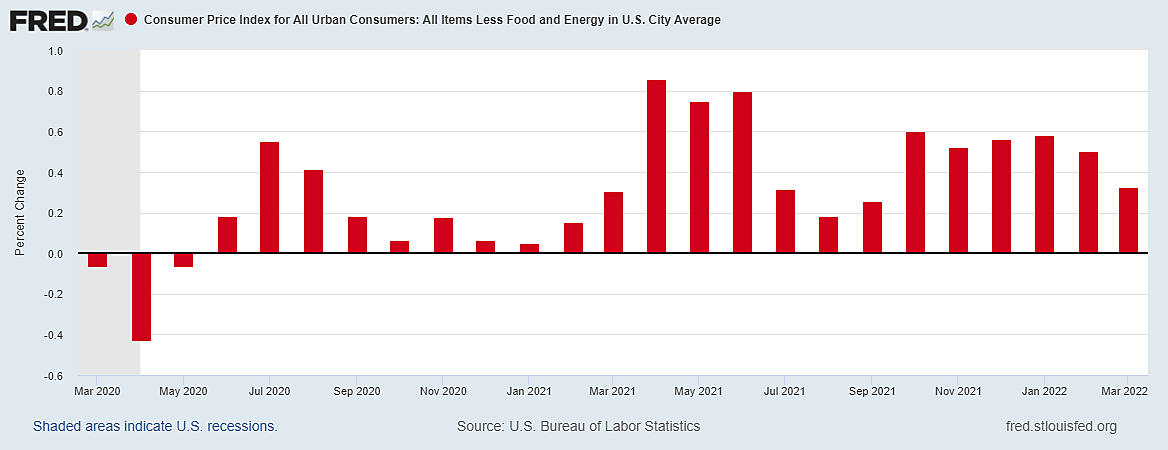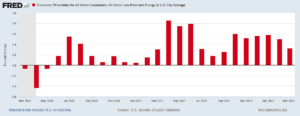

Alan Reynolds beat me to it, with an excellent analysis of the latest inflation numbers.
Alan notes that “CNBC, like others, reported that ‘The consumer price index accelerated 8.3% in April.'” No it didn’t. It rose by 8.3 percent from the same time last year. But the CPI rose by 0.33 percent in April. Compare that to its 1.2 percent rise in March.
Inflation came down. Do I expect it to come down further? Not necessarily. But I expect the month-to-month inflation rate to stay well below 1 percent and probably below 0.7 percent.
For my earlier discussion of this, see my “Badly Misleading Inflation Headlines,” EconLog, April 14, 2022.

READER COMMENTS
vince
May 11 2022 at 5:12pm
But core inflation did accelerate. It doubled from .3 percent in March. That concerns me more than the slight headline inflation decline from one year ago.
David Henderson
May 11 2022 at 5:43pm
Ah, good point.
Alan A Reynolds
May 12 2022 at 7:32am
The CPI core number looks like a statistical fluke. The BLS reported food prices up 0.9% which would have subtracted a lot from overall inflation, bringing the core down. But they also reported a 6.1% (?!) monthly drop in gasoline prices which neutralized the impact of soaring food prices in the core calculation.
The trouble is the BLS used a monthly average of daily gasoline prices, which did dip a little in mid-month. Gasoline prices were higher at the end of April than at the start and went on to reach a record high a few days later. The CPI numbers are subject to revision, or at least a footnote of explanation.
Energy prices excluded from core inflation are only the most direct ones: gasoline, electricity, natural gas utilities and fuel oil. Those energy items account for only 8.3% of the CPI while food prices 13.4%. But because fossil fuels are used to produce and distribute many non-energy goods, soaring world prices of oil, coal and gas have a far more pervasive impact on overall goods and services (airfares, bus tolls, trash collection) than core numbers capture.
The chain-weighted CPI rose a bit less than the fixed-weight version, which bodes well for the next PCE figure. PCE core inflation was 0.29% in February and March. If continued, that would by 4% year to year by June. But if PCE core also records a dubious fall in gasoline prices, read it with due caution.
Alan A Reynolds
May 12 2022 at 8:54am
Because I do not agree with the BLS that “gasoline fell 6.1 percent over the month,” I also do not believe the all items CPI was quite as low as reported (0.3) or that the core CPI was nearly as high as reported (0.6). The really big monthly gains were affected by war-related scarcity of foods (cereals and bakery up 1.1%) and fossil fuels (natural gas up 3.1%).
Prices counted among “all items” (not core) include Transportation Services which rose 3.1%. Jason Furman tweets that “This is the inflation story to worry about: core services inflation has increased for four straight months.” But what he wrongly calls “core services inflation” (services less energy services) includes Transportation Services. A useful measure of core inflation would exclude such services as airline and ship fares from the all items headline rate, but in fact they are very much included. Correcting for that thoughtless accounting convntion would have made both headline and core inflation numbers smaller than reported.
David Henderson
May 12 2022 at 10:31am
Thanks, Alan.
So next month’s data will be very interesting.
Craig
May 12 2022 at 2:41pm
” The BLS reported food prices up 0.9% which would have subtracted a lot from overall inflation, bringing the core down.”
The overall M/M was .3 so the food at .9 means that mathematically food brought the CPI up the M/M number.
“bringing the core down.”
Yes if core only excluded food, but core inflation excludes food and energy. So while I understand you’re taking issue with the drop in energy, mathematically by pulling out food AND energy, the core will be higher than the overall number because the drop in energy was that dramatic.
Jon Murphy
May 11 2022 at 5:29pm
I was pleasently surprised by this report. Two things I wanted to note:
First: the month to month rate of 0.3% was the slowest since August.
Second: Energy and used autos fell. Energy won’t stay that way (Here in New York, prices have jumped), but used cars is a good sign
Thomas R Jackson
May 15 2022 at 7:49pm
All of the year to year inflation comparisons so far this year are comparing depressed, recession prices with recovered prices.
Prices have recovered to the 2019 Q4 baseline plus 3.5%.
In other words, people are paying prices, today, as they would have been a year ago IF we did not have a recession and inflation was 3.5% in 2020.
Also, people are paying these baseline prices with wages that are 5% above what they were in 2019.
In other words, except for gasoline, people ARE NOT “falling behind” and inflation is NOT the huge hysterical problem that we are being told that it is.
Because we are still comparing depressed prices with recovery prices, inflation will go down each month this year as the price comparisons become closer BECAUSE price recovery began in May 2021 and continued to April 2022.
The inflation false narrative is nothing more than political trick that takes advantage of a statistical anomaly to try to trash talk the fastest recovery from a recession in history.
Craig
May 17 2022 at 8:24am
“Prices have recovered to the 2019 Q4 baseline plus 3.5%”
The CPI-W index Social Security uses is much higher than that. https://www.ssa.gov/oact/STATS/cpiw.html
So too is CPI-U
There were a couple of negative months and the following year people argued that the higher Y/Y inflation number was because of the base effects. Whether you use beginning of Q4 2019, end of quarter, start of pandemic either Feb or March 2020 and compare with today, the general price level is much higher 11%+ higher.
Comments are closed.